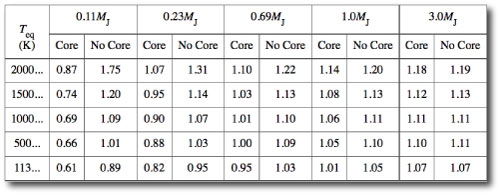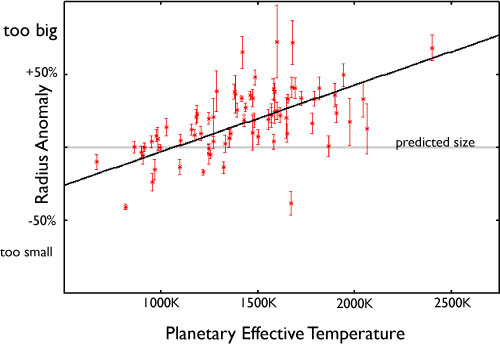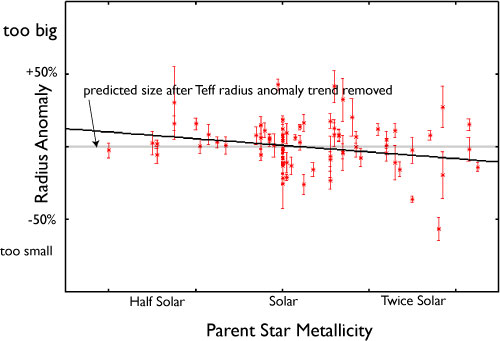The radii of the transiting extrasolar planets have been the source of a lot of consternation. It’s very hard to tell the mass of a planet simply by looking at how large it is.
In our own solar system, there’s a well-delineated correlation between planetary size and planetary mass, with the only modest exception being Uranus and Neptune. Uranus has the larger radius and Neptune has the larger mass. With the extrasolar planets, on the other hand, the situation is notoriously less clear-cut. Transiting planets, with HD 209458b providing the textbook example, are often considerably larger than expected, hinting at a cryptic energy source.
With the WASP and the HAT surveys firing on all cylinders, the catalog of well-categorized transiting planets has been growing quite rapidly. There are now close to 90 planets with reasonably well determined masses and radii, so I thought it’d be interesting to take stock of the catalog with an eye toward evaluating how bad the radius problem really is.
Back in 2003, Peter Bodenheimer and Doug Lin and I did a series of planet evolution calculations which solved for the equilibrium radii of giant planets made from hydrogen and helium (and both with and without solid cores). Our models spanned a range of planetary masses and surface temperatures, and they provide a baseline expectation for how large gas giant planets “should” be (radii are in Jovian units):
Clear trends can be seen by studying the table. For example, once planets get significantly more massive than Jupiter, they stop increasing their radii. This is a consequence of the interior equation of state growing progressively more electron degenerate. It’s also true that the hotter a planet gets, the larger it’s expected to be, and a core of heavy elements causes a planet to have a smaller overall radius.
With the baseline “no core” models in hand, it’s straightforward to see whether a newly discovered planet conforms to expectations. With some exceptions, the extrasolar planets have not tended to conform to expectations (a state of affairs that has held up quite robustly, in fact, across the entire exoplanet field, where theoretical predictions have rarely presented any real utility). A significant fraction of hot Jupiters are a lot larger than expected, and there are also some that have turned out to be considerably smaller than expected. For a given planet, we can define the “radius anomaly” as the fractional discrepancy between the predicted radius and the observed radius. A planet like HD 209458b has a large positive radius anomaly, whereas a planet like HD 149026b has a large negative radius anomaly.
One can garner clues to the source of the radius problem for extrasolar planets by regressing the radius anomalies against possible explanatory variables. The most dramatic effect comes when one plots radius anomaly as a function of effective planetary surface temperature:
As a general rule, the hotter the planet, the more severe the radius anomaly. This points to ohmic heating as the most likely culprit for pumping planets up. The hotter the planet gets, the larger the ionization fraction in the atmosphere, and the more effectively the weather is able to act as a toaster. Konstantin Batygin and Dave Stevenson’s recent paper on this topic is almost certainly barking up the right tree.
Another interesting correlation arises when one plots radius anomaly versus stellar metallicity after removing the planet temperature trend observed in the plot above. In this case, there’s a modest correlation with the opposite sign:
Planets with negative radius anomalies tend to orbit metal rich stars. This is a natural (and expected) consequence of the core accretion hypothesis for giant planet formation.
Simple linear dependencies on planetary temperature and stellar metallicity are able to account for more than half (but not all) of the observed variance in the radius anomalies. The missing factor could come from a number of sources — nonlinearity in the correct model description, observational biases, or perhaps something else altogether…
Finally, in the this-just-in Department, there’s a paper up on astro-ph this week detailing the discovery of HAT-P-18, and and HAT-P-19. These two planets certainly don’t enhance the suggestiveness of the above plots — their anomalies are anomalous. Both of the new Hats are relatively cool, relatively low mass planets orbiting relatively metal rich stars. And they’re both swelled up! Tidal heating? Could be.





OK, I wasn’t the only one to have noticed that. Try decomposing the planet Teff correlation into distance from star and luminosity – star Teff matters much more than distance from star. This could be linked to galactic cosmochemical evolution for easily-ionized Na and K. If magnetic braking of zonal flow is important for the most-inflated stars, dayside-nightside temperature contrast should be higher on the most inflated stars. Cowan and Agol is the most comprehensive compilation on the arxiv.
Best wishes, – Edwin
Pingback: Tweets that mention systemic » Radius Anomalies -- Topsy.com
Talking of radius anomalies, what do you make of the recently-announced HAT-P-20b? Over 7 Jupiter masses but only 0.867 Jupiter radii…
Pingback: Blog de Astronomia do astroPT » Planetas Inchados